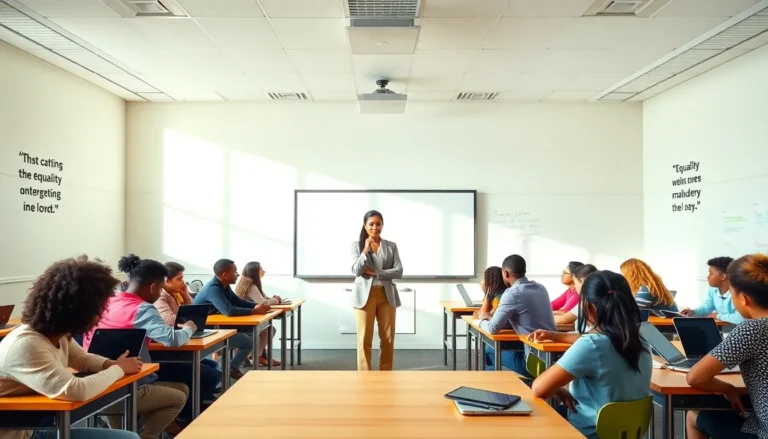In the whirlwind of student life, juggling assignments, exams, and social events can feel like trying to tame a wild beast. Enter student goal tracking, the trusty sidekick every learner needs. It’s like having a GPS for academic success, guiding students through the maze of their educational journey.
Imagine setting goals so clear that even a sleep-deprived college student could find them. With the right tracking tools, students can transform their ambitions from vague dreams into actionable plans. Plus, who wouldn’t want to celebrate those tiny victories along the way? Tracking goals not only boosts motivation but also adds a sprinkle of fun to the serious business of learning. So, buckle up and get ready to discover how goal tracking can turn chaos into clarity and help students conquer their academic mountains.
Table of Contents
ToggleUnderstanding Student Goal Tracking
Goal tracking serves as an essential strategy for students striving for academic achievement. This approach helps convert aspirations into actionable objectives, promoting focus and clarity throughout their educational experience.
Definition and Importance
Goal tracking refers to the systematic approach of setting, monitoring, and achieving educational objectives. This practice nurtures motivation and fosters a sense of accomplishment. Students who engage in goal tracking often display improved academic performance. They gain a clearer understanding of their strengths and areas needing improvement. Additionally, tracking progress allows for timely adjustments to study plans. The synergy between monitoring and motivation enhances learning experiences, making education more enjoyable.
Key Components of Goal Tracking
Effective goal tracking includes several critical elements. First, specific goals provide clear objectives for students to aim for. Measurable criteria help students evaluate progress toward these goals. Achievable targets ensure that objectives remain realistic and attainable, maintaining motivation. Relevant goals align with students’ long-term aspirations, enhancing commitment. Timely check-ins enable students to assess their performance at regular intervals. Utilizing digital tools or planners can further streamline the process, ensuring students stay organized and focused.
Benefits of Student Goal Tracking
Students find significant advantages in tracking their goals. This practice not only clarifies their academic path but also bolsters their overall learning experience.
Improved Student Motivation
Tracking goals fuels student motivation. When students outline specific objectives, they become more engaged in their studies. Achieving milestones boosts their confidence, often resulting in a greater commitment to learning. Celebrating small victories keeps motivation levels high. Increased accountability from tracking also ensures students remain focused. Visual progress allows them to see how much they’ve accomplished, which can amplify their desire to push forward.
Enhanced Academic Performance
Goal tracking correlates with improved academic performance. Students who use this method often demonstrate higher grades and better understanding of their subjects. Regular assessments of progress highlight strengths and weaknesses, leading to targeted improvement. The structured approach creates consistency in study habits. In addition, students develop time management skills, which further enhances productivity. Tracking tools equip them to prepare more effectively for exams and assignments, ultimately elevating their overall academic results.
Tools and Techniques for Effective Goal Tracking
Effective goal tracking tools and techniques help students manage their academic objectives effectively. Both digital and traditional methods offer unique benefits for this process.
Digital Platforms and Apps
Numerous digital platforms and apps facilitate goal tracking for students. Trello and Notion provide customizable boards for visualizing progress. Google Keep allows for quick note-taking and reminders, enhancing accountability. Students who prefer gamified experiences can find motivation in apps like Habitica. Analytics features in these platforms help track performance over time. Using reminders and notifications keeps students engaged and on track.
Traditional Methods and Worksheets
Many students also benefit from traditional methods and worksheets for goal tracking. Common techniques include bullet journals and planner systems that foster active engagement with goals. Checklists offer straightforward organization for daily tasks, enhancing productivity. Visual aids like poster boards can display long-term objectives, making them easily accessible. Regularly reviewing these worksheets promotes reflection on progress and areas needing improvement. Combining traditional and digital tools maximizes goal tracking effectiveness while catering to individual learning preferences.
Challenges in Student Goal Tracking
Tracking academic goals presents several challenges that can hinder student progress. Navigating these obstacles requires understanding and addressing them proactively.
Common Obstacles Students Face
Students often encounter time management issues when juggling multiple responsibilities. Distractions from social media or other activities frequently disrupt focus. Additionally, a lack of clarity in goal setting can lead to misplaced priorities, making it harder for students to stay motivated. Many struggle with accountability, as having external support is essential for maintaining commitment. Emotional factors, such as stress and anxiety, can also hinder perseverance, affecting goal achievement.
Strategies to Overcome These Challenges
Establishing a structured schedule helps students manage their time effectively. Setting clear, specific goals creates a focused roadmap for success. Utilizing accountability partners fosters a supportive environment that encourages consistent progress. To minimize distractions, students can designate specific study times, limiting social media usage during those periods. Incorporating regular check-ins allows students to assess their progress and adjust strategies as needed. Embracing relaxation techniques can also combat stress, enabling a more productive learning experience.
Student goal tracking is more than just a method; it’s a transformative approach to navigating academic challenges. By setting clear objectives and regularly assessing progress, students can enhance their motivation and performance. The blend of digital and traditional tools offers flexibility, catering to diverse learning styles.
Overcoming obstacles like time management and distractions is achievable through structured planning and support. As students embrace goal tracking, they not only gain clarity but also cultivate a sense of accomplishment that fuels their educational journey. Ultimately, this practice empowers them to take charge of their learning and achieve their full potential.



